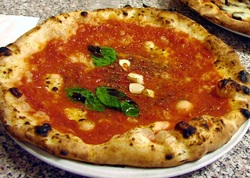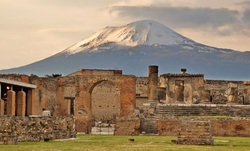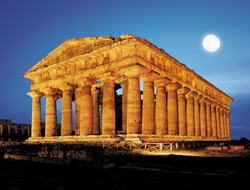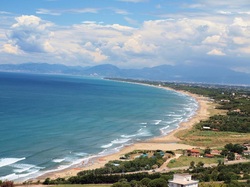 Our local hosts organized a three-day field trip to Southern Italy. At 5:30 on Friday morning, we boarded a chartered bus and headed to Naples. The participants on this field trip included not just students and faculty but also staff members, spouses, and one 9-year-old named Pietro ("Pete"). Our first stop was the Naples National Archeological Museum, where we saw relics and artifacts dating back more than two millennia. Afterwards, Jhan and I found a secluded little lunch spot, where we tried one of the traditional pizzas for which Naples is famous. Baked in a wood-fired oven and covered with homemade sauce, olive oil, fresh basil and garlic--but no cheese--it was like no other pizza we had ever tasted. Absolutely delicious! Now we see why Naples has earned such a stellar reputation for its pizza.  In the afternoon, we visited the ancient Roman town of Pompeii, which in 79AD was covered in 20 feet of ash over a four-day period following the eruption of Mount Vesuvius. Some of the 20,000 residents of Pompeii were able to escape, but most of them were buried in ash, as were all the buildings. When archaeologists began excavating the site in the 1800s, they discovered an ancient Roman city that was relatively intact. The layers of volcanic debris protected many of Pompeii's buildings, which included a traditional Roman forum, public baths (with a sophisticated system of indoor plumbing), an enormous amphitheater, beautifully crafted homes, and numerous temples--including the Temple of Isis, where Jhan and I got a bit distracted and became temporarily separated from the rest of our group. We eventually met up inside the amphitheater, where we watched the group come in through the tunnel that had once been the entryway of the Roman gladiators.  We spent Friday night in the modern city of Pompeii, which is relatively small yet bustling. The next morning, our first stop was a tour of a buffalo mozzarella factory. Like India, Italy has indigenous breeds of water buffalo. These amazingly docile and personable creatures are considered the source of the sweetest, creamiest mozzarella that Italy has to offer. The site we visited included both a factory and a farm, with hundreds of young and adult buffalo. Jhan and I made it a point to connect with every buffalo that would welcome us, which was the vast majority. While eating their morning hay, they would stop to let us rub, scratch, and caress their heads and necks. Some of them walked clear across the paddock to get our attention. We fell in love with these wise and wonderful animals, and it was hard to pull away. After sampling more cheese than we have ever been accustomed to eating in one sitting, we re-boarded the bus and traveled to the ancient beach community of Paestum.  First settled by Greeks in the 6th Century BC, Paestum is the home of three ancient Greek temples that are considered among the largest and most intact of these structures in the entire world. One of these temples is to Athena, and the other two are believed to be to Hera and Poseidon (although their origin remains a mystery). Before visiting the temples, we stopped in the local archaeological museum, which displays many of the artifacts found in and around the site. Two of the most interesting finds, at least for me, were a container of 2000-year-old honey and the tomb of an individual believed to be a shaman or seer. On the lid of the tomb is a carving of a figure that appears other-worldly.  The temples themselves are breathtakingly beautiful and enormous in size. They are evidence of the extraordinary ability of ancient Greek architects, engineers, and builders. Every detail of these temples was meticulously designed using sophisticated mathematical principles. We were so taken by the temples that we had not noticed the setting, which was one of the loveliest stretches of sandy beaches in all of Italy. That evening, Jhan and I had a chance to take a long walk on the beach, where we witnessed the intense splendor of a flaming red sunset. We were joined by our friend Lori, who shared with us her way of honoring dead loved ones by writing their names in the sand and then waiting for the waves to wash them away.  On Sunday, we began our return trip northward, stopping in the provincial capital of Caserta to take in the royal palace there. Built in the 18th Century for the Bourbon kings of Naples and Sicily, the palace itself consists of 1200 elaborately-decorated rooms. Inside the palace, we viewed an exhibit by a French photographer named Robert Doisneau. Being completely unfamiliar with his work, Jhan and I were surprised and delighted by the exhibit, which captures various aspects of Parisian life in the mid 20th Century. Some of Doisneau's photographs made us laugh out loud, whereas others were touching and poignant. Ironically, we were not brought to Caserta to see the inside of the palace or even the photo exhibit. What makes this site world renown is the gardens in back, which extend for over two miles and include extensive reflecting pools filled with fish and flowing into spectacular waterfalls.  The gardens themselves are almost too vast to be seen on foot. We decided to rent bikes to climb up to the top of the hill, which is the site of a major waterfall and also of an area that the local people refer to as an "English garden." This garden is actually an enormous arboretum containing trees from around the world, including fir, redwoods, oak, palms, and hundreds of other species. At the center of the arboretum is a large pond surrounded by structures designed to resemble ancient Greek ruins. Although we had a picnic lunch on the grounds, our preference might have been to just camp there for a few nights. As with all of the sites we visited on this field trip, the palace at Caserta is worthy not of a few hours but of days, weeks, or even months of exploration. The more we get to know Italy, the more we are in awe of its magnificent beauty. Compared to the US, there is little wilderness. But what we have seen is the spectacular ways that people have found to co-exist and co-create with nature. Sustainability is not just an abstract notion here, but rather a way of life that has been practiced for thousands of years. Needless to say, this place has inspired us in some unexpected ways. Our mantra for this trip has been, "Thank You. More Please." (Some of you may know the film reference). We are extremely grateful for all the unique people and places we have encountered thus far, but we also suspect that there are some wonderful new surprises to amaze and inspire us--just around the corner. We're delighted to receive all of the insights and gifts from this journey and take them back to share with our loved ones in Tucson, Omaha, Seattle, and beyond.
0 Comments
Leave a Reply. |
I want to hear from you! Please share your questions and comments. And sign up for my newsletter, where I will pass along the insights, ideas, and inspiration that come my way.
Contact me:Archives
November 2023
|

 RSS Feed
RSS Feed
